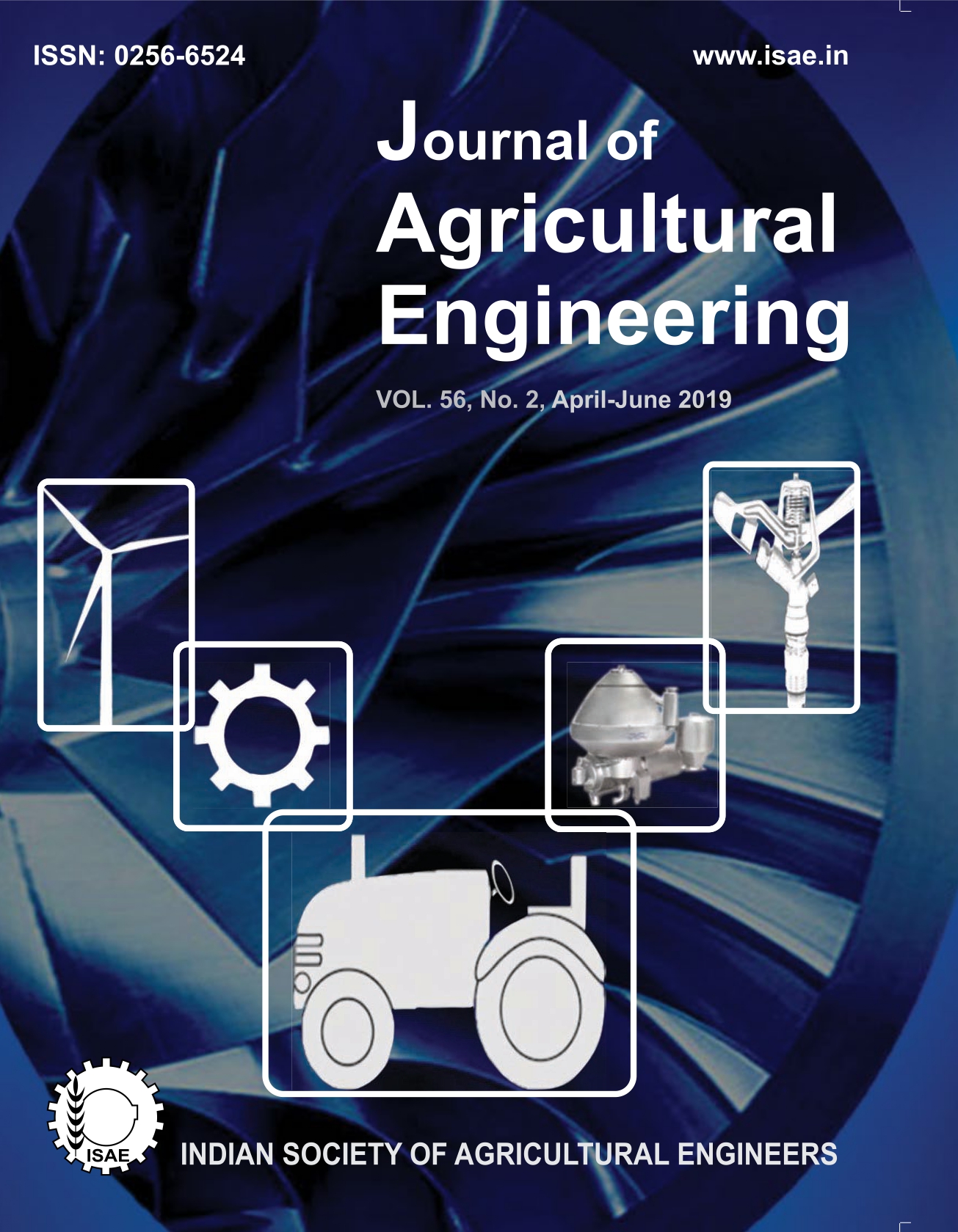Laboratory Estimation of Bio-crude Production Potential from Selected Agricultural Residues
DOI:
https://doi.org/10.52151/jae2019562.1679Keywords:
Pyrolysis, bio-crude, calorific value, flash point, fire pointAbstract
Pyrolysis is a better option for effective utilisation of surplus biomass and its utilization to liquid fuels. In this study, the technique of fast pyrolysis was adopted for the production of bio-crude from selected biomaterials viz. rice husk, coir pith, saw dust, cotton stalk, red gram stalk, groundnut shell and maize cob. Bio-crude production was done in a labscale fixed-bed pyrolytic system at six different temperatures (350°C, 400°C, 450°C, 500°C, 550°C and 600°C). Bio-crude yield was obtained in the range of 28 % to 52 %, and groundnut shell pyrolyzed at 550°C gave maximum percentage of bio-crude. The viscosity, pH, density, specific gravity, calorific value, flash point and fire point of biocrudes were evaluated using standard methods.
References
ASTM. 2006. Standard Test Method for Moisture Analysis of Particulate Wood Fuels. Standard E 871-82, D 445-72, American Society for Testing and Materials (ASTM), West Conshohocken, Pennsylvania.
ASTM. 2009. Annual Book of Standards. American Society for Testing and Materials, West Conshohocken, Pennsylvania.
ASTM. 2013. Standard Test Method for Ash from Petroleum Products. Standard D482-13, ASTM International, West Conshohocken, Pennsylvania.
ASTM. 2017. Standard Test Method for Density of Hydraulic Cement. Standard C188-17, ASTM International, West Conshohocken, Pennsylvania.
ASTM. 2018. Standard Test Method for Density, Relative Density, and API Gravity of Liquids by Digital Density Meter. Standard D4052, ASTM International, West Conshohocken, Pennsylvania.
ASTM. 2018a. Standard Test Methods for Flash Point by Pensky-Martens Closed Cup Tester. Standard D93-18, ASTM International, West Conshohocken, Pennsylvania.
Bardalai M; Mahanta D K. 2015. A review of physical properties of biomass pyrolysis oil. Int. J. Renewable Energy Res., 5(1), 277 - 286.
Gang X; Jiang N M; He H; Young C; Rui X; Ping Z; Ke-fa C. 2007. Fluidised-bed pyrolysis of waste bamboo. J. Zhejiang Univ. Sci. A, 8 (9), 1495-1499.
Jain P C; Jain M. 2016. Engineering Chemistry. Dhanpat Rai Publishing Company, New Delhi, 58-59.
Jenkins B M; Ebeling J M. 1985. Correlation of physical and chemical properties of terrestrial biomass with conversion. In: Proc. Symposium Energy from Biomass and Waste, IX, California, pp: 371.
Kumar A; Kumar N; Baredar P; Ashish S. 2015. A review on biomass energy resources, potential, conversion and policy in India. Renewable Sustainable Energy Rev., 45, 530-539.
MNRE. 2018. Annual Report 2017-18. Ministry of New and Renewable Energy, Government of India, New Delhi. https://mnre.gov.in/file-manager/annual-report/2017-2018/EN/pdf/3.
Mythili R; Venkatachalam P; Subramanian P; Uma D. 2013. Characterization of bio residues for bio oil production through fast pyrolysis. Bioresour. Technol., 138, 71-78.
Raveendran K; Ganesh A; Khilar K C. 1996. Pyrolysis characteristics of biomass and biomass components. Fuel, 75, 987 - 98.
Rezaei P S; Shafaghat H; Daud Wan Mohd Ashri Wan. 2014. Production of green aromatics and olefins by catalytic cracking of oxygen at ecompounds derived from biomass pyrolysis: A review. Appl. Catal. A-Gen., 469, 490-511.
Singh H; Sapra P K; Sidhu B S. 2013. Evaluation and characterization of different biomass residues through proximate and ultimate analysis and heating value. Asian J. Eng. Appl. Technol., 2(2), 6-10.
Sluiter A; Hames B; Ruiz R; Scarlata C; Sluiter J; Templeton D. 2004. Determination of Structural Carbohydrates and Lignin in Biomass. NREL Analytical Procedure. National Renewable Energy Laboratory, Golden, Colorado.
Xie H; Qingbo Y; Qin Q; Zhang H; Xinglong F. 2013. Bio-oil production by fast pyrolysis from agriculture residue in north-eastern China. J. Renewable Sustainable Energy, 5(1), 1-8.
Xiu S; Shahbazi A. 2012. Bio-oil production and upgrading research: A review. Renewable and Sustainable Energy Reviews, 16, 4406 - 4414.
Yang H; Yan R; Chen H; Lee D H; Zheng C. 2007. Characteristics of hemicellulose, cellulose and lignin pyrolysis. Fuel, 86, 1781-1788.
Yin R; Liu R; Mei Y; Fei W; Sun X. 2013. Characterisation of bio-oil and bio-char obtained from sweet sorghum bagasse fast pyrolysis with fractional condensers. Fuel, 112, 96-104.
Zanzi R; Sjostrom K; Bjornborn E. 1996. Rapid high temperature pyrolysis of biomass in a free-fall reactor. Fuel, 75 (5), 545-550.
Zhang H; Xiao R; Huang H; Xiao G. 2009. Comparison of non-catalytic and catalytic fast pyrolysis of corncob in a fluidized bed reactor. Bioresour. Technol., 100(3), 1428-1434.














